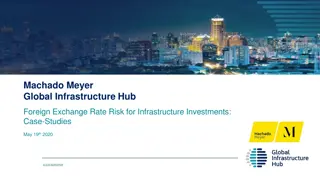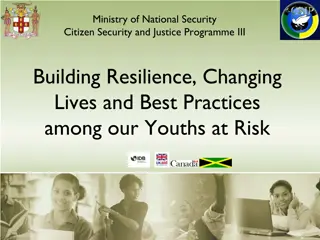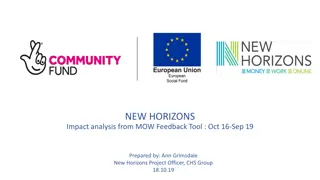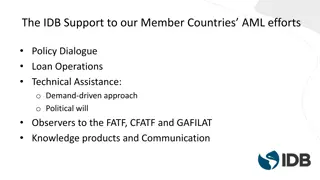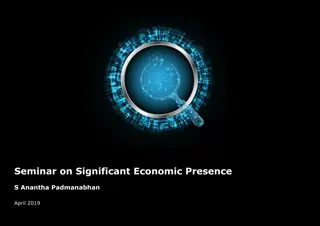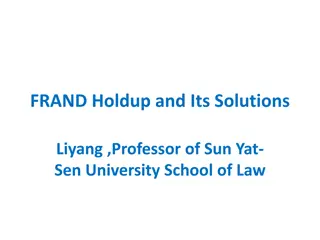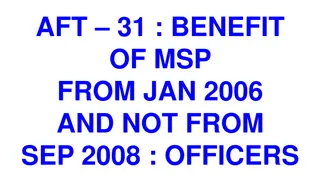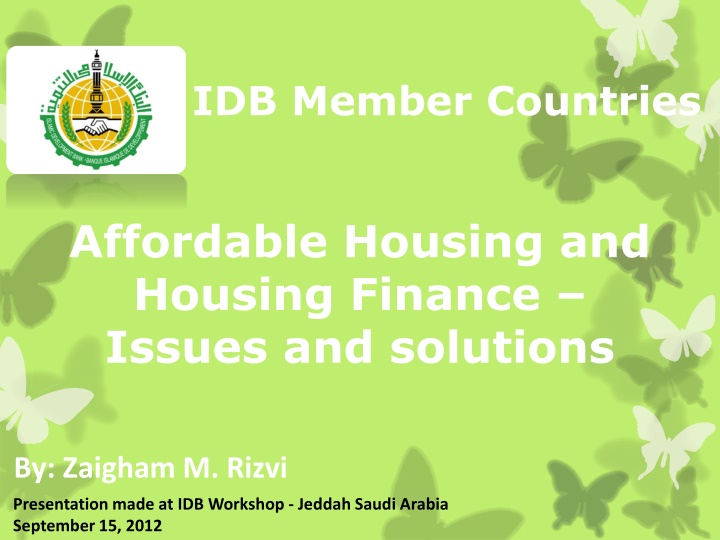
Housing Challenges and Finance Issues in Muslim Countries
Explore the critical issues of affordable housing and housing finance in Muslim countries, focusing on the widening demand/supply gap, rising housing backlog, and the challenges faced by low-income populations. Learn about the need for institutional housing finance and the scarcity of long-term liquidity facilities in this insightful presentation by Zaigham M. Rizvi.
Download Presentation

Please find below an Image/Link to download the presentation.
The content on the website is provided AS IS for your information and personal use only. It may not be sold, licensed, or shared on other websites without obtaining consent from the author. If you encounter any issues during the download, it is possible that the publisher has removed the file from their server.
You are allowed to download the files provided on this website for personal or commercial use, subject to the condition that they are used lawfully. All files are the property of their respective owners.
The content on the website is provided AS IS for your information and personal use only. It may not be sold, licensed, or shared on other websites without obtaining consent from the author.
E N D
Presentation Transcript
IDB Member Countries Affordable Housing and Housing Finance Issues and solutions By: Zaigham M. Rizvi Presentation made at IDB Workshop - Jeddah Saudi Arabia September 15, 2012
Housing is a Numbers game The Muslim World is no exception! The Muslim world represents 1 of 4 humans on the planet Nearly the same share in number of countries Represents 1 of 2 poor on the planet An acute challenge of widening demand/supply gap and rising housing backlog Most of the housing backlog and short supply is in low- income segment of the population Population growth and urbanization are further compounding the existing huge backlog Rising costs (land, construction, construction materials) are making housing unaffordable for the poor 2 Presentation on Housing and Housing Finance by Zaigham Rizvi
Housing Supply Challenge Figures speak for themselves IDB study suggests housing needs of the Muslim World at 8 mn units, nearly all in Low-Income Segment The estimate needs further analysis and breakdown MENA 3.2 mn; Asia 2.7 mn; and Africa/others 2.3 mn. Urban population likely to rise from 1/4th to 1/3rd of total Rapid Urbanization a major issue in low income housing Need for new housing of 8 mn due to population growth is based on 5-5.5/HH and population growth at 2.5% Urbanization and population growth further increases the year-on-year housing needs in major metropolitans Supply is 30-40% on new demand for housing 3 Presentation on Housing and Housing Finance by Zaigham Rizvi
Housing Finance Challenges As most of housing shortage is in low income segment, poor need empowerment through housing finance Institutional Housing Finance is either non-existent or in infancy stages in most of the Muslim World (Afghanistan and some African Countries) Slightly advanced in some others (Malaysia, Turkey, Egypt, Morocco, Indonesia, Pakistan and Saudi Arabia) Regulatory Framework is also quite similar Additional challenges include: Role and responsibilities of Specialized Housing Finance Institutions (HFIs) and Commercial Banks (CBs) Long Term Liquidity Facility Institutions and Instruments 4 Presentation on Housing and Housing Finance by Zaigham Rizvi
An Asian Snapshot Asia-Pacific represents: 1/4th of the Worlds population, and Nearly of the Worlds Poor Housing is an essential part of political sloganizm Housing for all ; Slum Free Cities Maang Raha hai har Insaan-Roti, Kapra, aur Makan (Every human demands food, clothing and shelter); etc. In some countries there is SOME delivery but in most there is NONE Each country in the region has its own geo-socio- economic parameters and all face a common issue of shelter less poor Regional successful models would be need for sharing experience and knowledge 5 Presentation on Housing and Housing Finance by Zaigham Rizvi
Regulatory Regimes Much more needs to be done Central Banks as regulators with limited focus on housing Need to strengthen regulatory regimes with development and implementation of: Prudential Regulations; Mortgage Guidelines; Developer Finance Framework etc. Mortgage Law/Foreclosure Law with a focus on Sharia- Compatible Housing Finance Housing Finance Regulatory Framework for developers and construction industry with a focus on Low-Cost Housing Fiscal Regimes with a focus on Low Income Housing ( LIH ) Country specific definition of Affordability in term of Cost of house and area 6 Presentation on Housing and Housing Finance by Zaigham Rizvi
Sharia-Compatible Housing Finance An issue of faith e.g. Afghanistan with nearly 100% Muslim Population Also an issue of Financial Inclusion. Even if conventional finance is available, Faith-Based clients do not availit Standardization and Diversification of RE/Housing Products on Asset Side and Liability Side Islamic REITS and MBS Products Role of Islamic Banks and Islamic Windows of Conventional Banks Need for Research and Development Center 7 Presentation on Housing and Housing Finance by Zaigham Rizvi
Housing Information System Housing Observatory No Muslim country has any Housing Observatory or Housing Information System-HIS (exception Egypt) To address the challenge of Pro-Poor LIH detailed data on Income Segments, Affordability in terms of Finance and Supply are needed Central Banks need to play a pro-active role in compilation of Data on Housing Finance, Income and Affordability Such data should cover Geographical and Income segments Developers and Governments ( e.g. Housing Ministry) need to compile data on Housing Supply An increased role of Developers Associations, Mortgage bankers Associations, and bodies of other Stakeholders 8 Presentation on Housing and Housing Finance by Zaigham Rizvi
Housing Challenges in Asia-Pacific region Region represents more than 1/4th of Worlds population and of the poor on the planet Including China, Asia-Pacific represents of the Worlds population Region still among the lowest in terms of Mortgage Finance Average Mortgage Debt to GDP Ratio 3.3 Region is faced with massive housing shortage India alone faces an Urban Housing shortage of 27 mn Nearly entire urban shortage is in Low-Income Category Persons per Room Density: India/Pakistan is 3.5; EU is 1.1; and USA is 0.5 10 Presentation on Housing and Housing Finance by Zaigham Rizvi
Population explosion in Asian Cities In 1950, about 232 mn people lived in urban areas representing 17% of Asia s total population. Today it is more than 1/3rd and by 2025 nearly of Asian Population will be Urban By 2030, 1 of every 2 urban residents in the world will reside in Asia In India, as per census 2001, total housing stock was 249 mn units of which 29% (72 million) were in urban areas. India today faces an Urban housing shortage of 25 mn units (Pakistan around 3 mn) Nearly entire Urban Housing Shortage is in Economically Weaker Sections of society India, Thailand, Indonesia, Malaysia and more from the region have unique success stories in different areas Regional countries could benefit from knowledge and experience sharing 11 Presentation on Housing and Housing Finance by Zaigham Rizvi
Slums Prevalence in Asia Afghanistan: 80% of Kabul s population (2.44 mn) live in slums or damaged/destroyed housing Bangladesh: 2,100 slums. In Dhaka, 2 mn people live either in slums or are without any proper shelter India: 52,000 slums providing housing to 8 mn people (about 14% of the total urban population) Pakistan: Karachi alone has between 600-800 slums sheltering 7.6 mn people (1 million households) out of the total city s population of 15.1 mn people Sri Lanka: A considerable share of the population of Sri Lanka lives in plantations, slums or shanties Mongolia: 51% of the population residing in temporary ger dwellings Indonesia: 17.2 mn families live in approximately 10,000 slum areas 12 Presentation on Housing and Housing Finance by Zaigham Rizvi
Where the Urban Poor Live Slums known through various names across the region: Shanty Towns, Jhopar Patti, Jhuggi, Basti, Katchi Abadi, Squatter Settlements, legal/illegal habitat, etc Hidden behind higher persons per room density Most, if not all, shelter in slums In some cases homeless poor live on footpaths, and even in abandoned sewerage pipes Nearly 50% of major metropolitans in the regions are slums A two pronged approach is required: Slums improvement programs; and Slums rehabilitation programs 13 Presentation on Housing and Housing Finance by Zaigham Rizvi
Urban Realities A glimpse into reality 14 Presentation on Housing and Housing Finance by Zaigham Rizvi
Role of the Developer Industry and the Construction Industry
Major players in the Construction sectors Developers/contractors; Designers; Construction material Industry (CMI); Labor/employment; Financial Institutions/Banks; Capital Market (REITs, MBS, Sukuk etc.); Regulatory agencies/Fiscal Authorities; Trade Associations; and above all the Federal and Provincial Governments 16 Presentation on Housing and Housing Finance by Zaigham Rizvi
Construction sectors covers the following Real Estate Residential real estate (retail & wholesale) Commercial real estate (office, markets etc) Industrial Infrastructure 17 Presentation on Housing and Housing Finance by Zaigham Rizvi
Contribution to Construction Material Industries (CMIs) In the developed world, the real estate sector contributes to the growth and development of 71 CMIs Contribution to GDP is 7-10%. In the developing world, its contribution spreads over about 42 CMIs Contribution to GDP is 3-6%. The main industries are steel, cement, wood, electrical, and ceramics 18 Presentation on Housing and Housing Finance by Zaigham Rizvi
Construction industry and challenges of low cost housing India faces an urban housing shortage of 27 mn units - nearly all in low income category Pakistan faces an urban housing shortage of 3-4 million units - again nearly all in low income category In Afghanistan, nearly 90% of population is a candidate for housing micro finance Low income housing: Is a challenge to the developer industry; and Needs to be addressed in a professional and commercially sustainable manner 19 Presentation on Housing and Housing Finance by Zaigham Rizvi
Urbanization Challenges
Urbanization Explosion World population expected to reach between 7.9 to 10.9 billion by 2050 By 2030, nearly 60% of the worlds population will be urban, and nearly will comprise of urban poor living in poor habitat and in slums Urban growth rates highest in the developing world, absorbing an average of 5 mn new urban residents/month Responsible for 95% of world s urban population growth Factors contributing to urban migration are: greater economic growth, rising income levels, employment opportunities in the cities, occupational shift from agriculture to manufacturing and services, and changing attitudes towards consumption and life style Changing family culture and shrinking household size. Slum population in India has increased from 26 mn units in 1981 to 61.8 mn units in 2001 21 Presentation on Housing and Housing Finance by Zaigham Rizvi
Housing Micro-Finance (HMF) Nearly 1/5th of population in the Muslim World is a candidate for HMF At this income segment people are more concerned on Faith-Based Finance Issues with HMF: Product Design; Outreach; MF Housing Microfinance Regulations; Income Assessment; Appraisal, Surveillance; Delivery; and Recovery Facilitate and management of Default 22 Presentation on Housing and Housing Finance by Zaigham Rizvi
HMF Institutional Framework Social Housing Finance Institutions (HMFIs) Social Housing Finance Institutions with a focus on slums improvement, Incremental Housing etc Sponsor a Shelter Programs: as delivery channels for Charity, Zakat. Specific Regulatory Regimes for HMF, both for financiers and developers Specific Fiscal Regimes on Smart Subsidies and Cross Subsidies Need to define HMF for regulatory and fiscal support 23 Presentation on Housing and Housing Finance by Zaigham Rizvi
Institutional Framework for Housing at Government Level Define roles at Federal and Provincial Level Integrate Housing and Urban Planning Housing Policies Land Banking and Role of the Government Smart Subsidies and Cross Subsidies Wisdom Sharing with all Stakeholders 24 Presentation on Housing and Housing Finance by Zaigham Rizvi
Pakistan: Some statistics Population: 160-170 million 2/3rd Rural, 1/3rd Urban Major metropolitans: Karachi, Lahore, Rawalpindi/Islamabad, Peshawar, Hyderabad and Faisalabad facing high rate of urbanization Karachi: Population 16-17 mn and growing @ of 7 to 8% Nearly half of Karachi s population is in squatter settlements (600-800 squatter settlements) Karachi only needs 100,000 new housing units per year to meet natural growth, cover backlog and urbanization pressure 26 Presentation on Housing and Housing Finance by Zaigham Rizvi
Housing Continuum in Pakistan Housing Finance Player Market Segment Income Distribution in % Rs High - High 1 % Commercial Banks 1 Lac & above. Rs 5.0 & above 0.075 Rs 2.5 to Rs 5.0 High End 4 % 0.300 Rs.100,000 Market Housing Rs.25,001 to Rs.50,000 Upper Middle HBFC (SMH) 15 % 1.125 Rs 1.25 ~ 2.50 Lower Middle Rs.10,001 to Rs.25,000 Rs 0.5 ~ 1.25 20 % 1.500 HBFC & Social Housing Bank Rs.4,001 to Rs.10,000 Rs 0.20~Rs.0.50 Small 40 % 3.000 Social Housing Micro 20 % 1.500 Upto Rs.4,000 Rs 0.20 Housing Shortage * (millions) Housing Market Mortgage Affordability (Rupees in millions) - Per Capita Income: Rs.5,000 per month - Minimum Wage Rate Rs.4,000 per month * Total existing backlog is estimated at 7.5 mn units. The shortage in various income segments is assumed in the same proportion as per income distribution pattern. However, actual shortage is much higher in low income segments as opposed to higher income segments. 27 Presentation on Housing and Housing Finance by Zaigham Rizvi
Afghanistan Afghanistan has a population of nearly 27 mn people Most of its population is a candidate for HMF Three to four decades of war has partially or totally destroyed institutional infrastructure in many cities Land records have been either destroyed or manipulated In Kabul Land Records are now being recreated and computerized under LIETRA Project Only Specialized HFI which existed in the past has been closed down for various reasons In Kabul only, an estimated $ 2.5 Bn are needed to repair and rehabilitate damaged/destroyed housing (World Central Bank of Afghanistan (DAB) is actively working on different initiatives on housing and seeks TA and Funding Support 28 Presentation on Housing and Housing Finance by Zaigham Rizvi
Case of some other countries Recent uprising in some ME Countries have brought to surface the social issue of low-income affordable housing Nearly all countries in the region have allocated huge funding and have initiated plans and projects to address it Most of these programs are based on State Subsidy, and thus would not be viable and sustainable in the long run. Indonesia, over the years have developed and implemented a very comprehensive program of State Subsidized Pro-Poor Housing. Africa has a unique challenge of Low-Income housing, with challenges of Affordability, HMF, major Slums etc. In many African Countries, largely Muslim population is a candidate for Sharia-Compatible Housing Finance 29 Presentation on Housing and Housing Finance by Zaigham Rizvi
A few recommendations Develop country specific Housing Observatory and HISs Standardize and simplify Sharia-Compatible Housing Finance Products Regulatory Regimes and Regulations Proactive role of National and Provincial governments in Housing, supported by proper institutional framework Capacity Building Creation of an Affordable Housing Fund Channeling Loans through Community Savings Groups Strengthening of Laws related to Recovery of Loans Need for Exclusive and Intermediate Institutions Need for continuous Dialogue and Dissemination 30 Presentation on Housing and Housing Finance by Zaigham Rizvi
A few recommendations (cont.) Risk Mitigants: Credit Guarantee Programs, Mortgage Insurance Title Insurance Credit Bureaus Alternative Forms of Collaterals Mortgage Counseling and Consumer Education Technical Assistance for Low cost construction Technologies and, Construction Materials 31 Presentation on Housing and Housing Finance by Zaigham Rizvi
A need to share common wisdom and experience Issues are common, answers are different and not shared Experiences are varied but rarely documented Essential to promote Networking and Joint Ventures An immediate need to share: Low Cost Construction Technologies Low Cost Construction Material Builders with technical and financial muscle Long Term Funding, issues and answers Product innovation and experiences Policy Initiatives and Programs in different countries Provision of Affordable Serviced Land, and Land Banking Housing Micro-Finance Institutions Use and Abuse of Subsidies (Smart Subsidies vs. Charities) 32 Presentation on Housing and Housing Finance by Zaigham Rizvi
Issues we know Answers we need Generally Political Sloganizm Housing for all , Slums Free Cities , Maang Raha hai har Insaan-Roti, Kapra, aur Makan , and so on In some countries delivery is SOME, and in most it is NONE Each country facing a common issue of shelter less poor with an ever increasing backlog Regional successful models are to be shared and INDIGENIZED Islamic Development Bank to play a pivotal Role 33 Presentation on Housing and Housing Finance by Zaigham Rizvi
Potential Roles for IDB Set up an exclusive function for Housing World Bank, ADB have now well equipped functions on Housing and Housing Finance, liked to Urban Development Technical Assistance on housing to member countries Funding Support and LT Credit Non-Funded Credit Enhancement Support Promote country specific and region financing instruments like Securitization (MBS), i-REITS etc Help establish LT Liquidity Facility Institutions Research, Development, Knowledge Sharing Platform at IDB Housing Data/Info Centre for the Muslim World (like HOFINET Fund Projects to convert Raw Land to Serviced Land Computerization of Land Records and Mortgage Registry 34 Presentation on Housing and Housing Finance by Zaigham Rizvi
Thank you Mr. Zaigham Mahmood Rizvi zaigham2r@yahoo.com Expert Consultant Housing: The World Bank Adviser Housing: State Bank of Pakistan Secretary General: Asia-Pacific Union for Housing Finance-APUHF www.apuhf.info Notice: This document has been prepared by Mr. Zaigham Mahmood Rizvi for the sole purpose of providing a presentation document to the Islamic Development Bank for the Workshop to be held on September 15, 2012. The information contained in this document has been compiled by Mr. Rizvi and includes material obtained by him. This document also contains confidential material proprietary to Mr. Zaigham Mahmood Rizvi and can not be distributed without his explicit permission. 35




